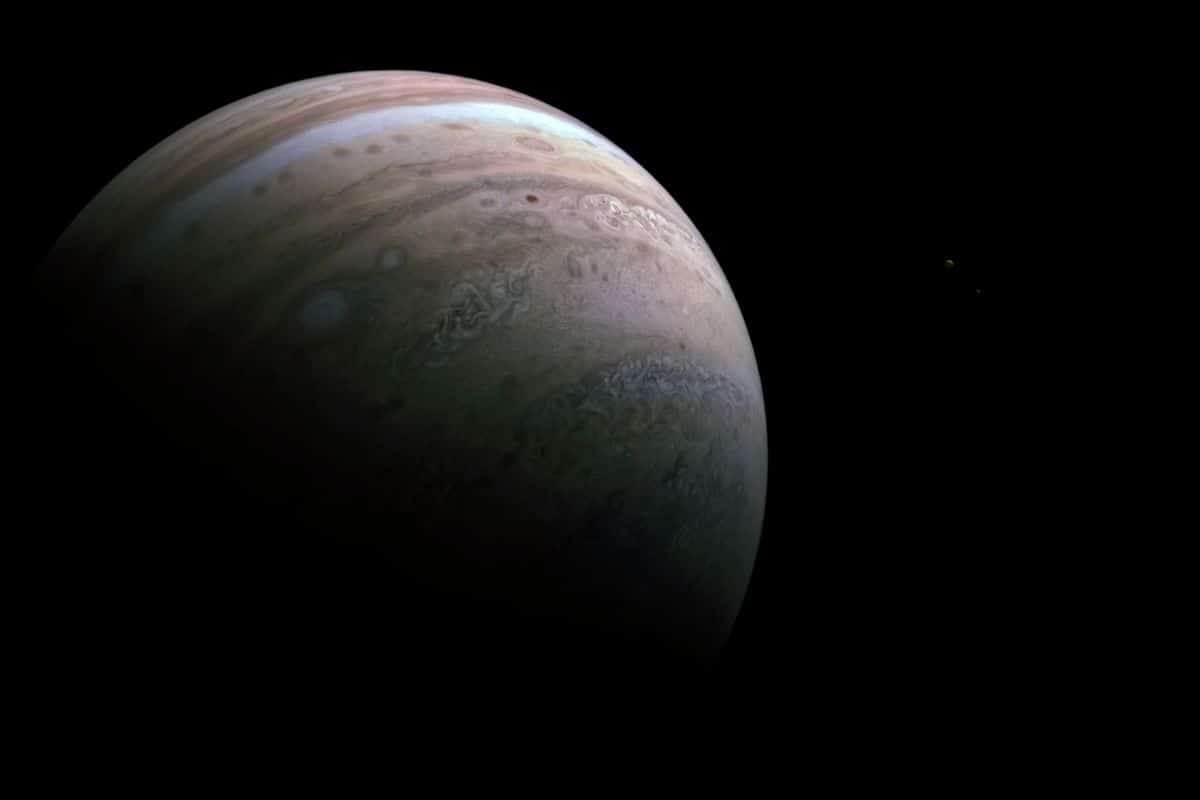

Three worlds in one photo, one of which could harbor life.
The Juno spacecraft captured a spectacular image of the gas giant during its 39th flyby of Jupiter. And if you zoom in, you will encounter two more surprises in the photo: the moons Io and Europa are also on it!
Southern hemisphere
Juno filmed the footage in January, but NASA has only just released the result. Juno was about 61,000 kilometers from Jupiter’s cloud tops when the images were taken. By the way, Jupiter is not completely visible; the photo only shows the southern hemisphere.
two moons
To the right of the gas giant, two moons can be seen: Io and Europa. They are only shadows in these photos, but that is about to change. Juno will, for example, fly close to Europe in September. The probe will approach the moon’s surface as far as 355 kilometers and – using various instruments – make considerably more detailed observations. This will undoubtedly provide new insights, because the last time a space probe came so close to Europe is several decades behind us.
Europa’s sightings are more than welcome, as in recent years this moon has emerged as one of the best candidates for extraterrestrial life. Beneath the moon’s icy surface is said to be a global ocean that may harbor life. To investigate this further, several missions to Europe will be undertaken in the coming years. For example, ESA will launch the Jupiter Icy Moons Explorer and wants NASA a year later the Europe Clipper launch. The data that Juno is already able to collect about Europe will certainly come in handy.

If you zoom in on the images, two moons appear on the right: Io (left) and Europa (right). By the way, Juno didn’t deliver this photo to Earth like that. Juno sends raw images to Earth that are processed and analyzed here – mostly by civilian researchers. This recording was edited by Andrea Luck. Image: NASA/JPL-Caltech/SwRI/MSSS.
Io
But it is not only Europe that can enjoy extra attention from Juno. The moon Io is also being studied in even more detail by the spacecraft. Juno will pass the moon in late 2023 and early 2024.
Extended and Extended Mission
The observations of Jupiter’s moons are very exciting, but surprisingly they were not originally part of Juno’s mission. The spacecraft was primarily designed to investigate Jupiter. But in early 2021, NASA decided to expand its mission objectives and also deploy Juno to study three of Jupiter’s moons — in addition to Europa and Io, including Ganymede — and the gas giant’s rings.

Juno’s mission has been extended by 42 orbits around Jupiter. During those extra orbits, Juno flies not only past three of Jupiter’s moons, but also close to the north pole of the gas giant. Image: NASA/JPL-Caltech/SwRI.
Juno will certainly have until September 2025 to check off the extensive mission objectives. Not bad for a probe that should have died in 2018. Funnily enough, the fact that Juno is still there is partly the result of a major setback. NASA had wanted to place the probe in a fairly close orbit around Jupiter, but it didn’t work; the probe lingered in the wide, oval-shaped orbit in which NASA had planned to place it temporarily after arriving at Jupiter. However, the setback also turned out to have advantages, for example Juno was exposed to considerably less harmful radiation in this orbit, which means that the probe can last longer. “We found that Jupiter’s radiation environment in this orbit is much less extreme than expected,” said lead researcher Scott Bolton in 2018, when the mission was extended to summer 2021. “And that is not only beneficial for our spacecraft, but also for our instruments and the quality of the data.” A second extension therefore took place in 2021. And as a result, for the next four years, we can regularly look forward to beautiful images and new insights, both about Jupiter and some of its most interesting moons.
Source material:
†NASA’s Juno Spacecraft Glimpses Jupiter’s Moons Io and Europa” – NASA.gov
Image at the top of this article: NASA / JPL-Caltech / SwRI / MSSS